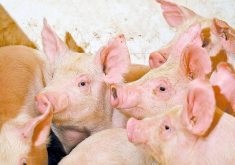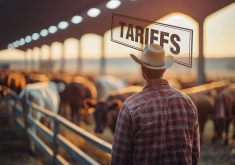CHOKE POINT West Hawk Lake, Manitoba is the sole zone reporting point in the country because of its ideal location
The tree-covered resort area at West Hawk Lake on the edge of the Canadian Shield on the Manitoba-Ontario border doesn’t look much like livestock country, but it’s a key location in the event of an animal disease outbreak in North America.
It owes that designation to an industry wake-up call after the European foot-and-mouth outbreak in 2001.
“It caused people to stop and think about what we could do here in Canada to control or reduce our risk, and the long-term impact of a foreign animal disease outbreak,” said Betty Green, a Manitoba cattle producer and chair of Zone Canada, so named after an initiative to designate Canadian livestock movement zones.
Read Also

Horns aren’t unlocking anytime soon on livestock transport standards
Standards good enough meet the definition of “humane” animal transportation still vary widely between what what industry wants, what animal rights advocates want and, between the two, what federal regulators decide is good enough.
“We started talking about some of the mitigation strategies that we could undertake, both in terms of training producers and preparing as a country for an outbreak and of course, zoning became one of those initiatives,” said Green.
Zoning is a containment tool allowing a nation to track animal movement in an organized way as it is being transported from one place to another. The data is collected and stored, and accessed only in the event of a disease outbreak.
Zoning requires a checkpoint where all livestock movement can be easily reported without slowing commerce. Natural choke points were sought and West Hawk Lake was the first selected because of its relative isolation.
West Hawk Lake is on the Trans-Canada Highway and is the only connection for vehicles crossing between Eastern and Western Canada. In addition to the highway, there are two nearby railways bridging the nation.
The reporting site is similar to a weigh station. In order to cross through, each load requires a permit and to obtain that permit, three pieces of information must be collected — the sender of the animals, the receiver and the means of transportation, including the licence plate. “And then of course we’ll also add what animals were moved and if possible, individual identification numbers, so the RFID tags in the case of cattle,” said Green.
Still need paper trail
Traceability measures slowly being introduced to the livestock sector will speed the process in the future, but at least for now, a paper trail is still an inevitability. “We started out by saying this should be an electronic permit that’s remitted to the site in advance of the load arriving. That doesn’t always work, that’s one thing we learned. We added the flexibility to allow producers to send that permit in paper form, by fax, by email or by phone call if necessary, so that we get all the pieces of information required,” Green said.
In the event of an outbreak, the CFIA immediately assumes responsibility, and will access the database to determine whether any animals from the infected area have been moved through the zone during the incubation or exposure period.
“The minute they have determined where those animals moved to, they would be isolated and tested to see if in fact the disease had spread and there are records of which trucks were used so they can isolate those and contain the disease much quicker,” Green said. That ability, so long as the zoning protocols meet the World Organization for Animal Health guidelines, can prevent borders from closing as it demonstrates outbreak containment and management.
The reporting site is up and running, but it is not currently mandatory. The first 18 months of operation are currently being analyzed by different government agencies. Green is optimistic the project will become permanent.
“They are assessing the accuracy of our information and as we’re doing our work, the CFIA is working with the USDA on having them recognize our capability to zone. So there are pieces underway at different levels,” Green said.
Other reporting sites across the country at strategic points will likely be added as the initiative matures. Before zone reporting becomes mandatory, regulatory changes will have to be made by the federal government. More information on the project can be found at www.zonecanada.ca.














